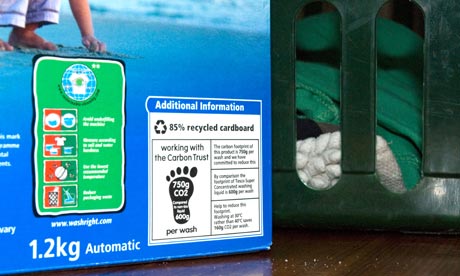"A major barrier to improved energy efficiency in households seems to be a lack of understanding of the impacts of various actions and products,"
"Providing information would lower this barrier, allowing consumers to make more informed choices without substantial effort."
"The value of the label comes not from providing perfect information, but better information than the consumer has at present."

Nonetheless, if anyone does manage to find, read, and understand these things (which I suspect is a major barrier to their effectiveness) they might have a few surprises.
- Bananas are GOOD (480g CO2 per kilo).
Bananas are grown in natural sunlight, which means that no energy-intensive hot-housing is required. Whats more is that they keep incredibly well. This means that, even though they are often grown thousands of miles away, they are transported by boats, which per kilo of freight transported, emit only 1% as much CO2 as planes do. There is also rarely any packaging. Even the light plastic bag or wrapper probably pays for itself carbon-wise by reducing the chance of customers ruining the fruit when they try to split a bunch. - Milk is BAD (1400g CO2 per litre), Meat is VERY BAD and air-flown asparagus is VERY VERY BAD (but maybe you knew that anyway...)
- New Zealand food is GOOD, UK food is BAD (even despite the air miles). This reflects the less intensive methods used in NZ compared to the UK. For example
Apples: Bizzarely, NZ is also more energy efficient in producing and delivering apples to the UK market than the UK is. Even when transport is added, NZ energy costs are approximately 60 per cent of those in the UK. Consequentially, the CO2 emissions per tonne of apples produced are also higher in the UK than in NZ, reflecting the higher energy use but also the lower emissions from NZ electricity generation.
Lamb: Even worse. The energy used in producing lamb in the UK is four times higher than the energy used by NZ lamb producers, even after including the energy used in transporting NZ lamb to the UK. So, NZ CO2 emissions are also considerably lower than those in the UK. But even then, a 100 gram portion of New Zealand lamb exported to Europe creates 1.9kg of CO2; about a five mile trip in a car.
Cumulatively, the cost of food over the year can add up; most people's yearly footprint is about 2 tonnes of CO2. To vaguely put this in context, 440kg (440,000g) of CO2 is equivalent to flying from London to Glasgow and back with 15-mile taxi rides to and from the airports. Or doing your laundry for a year.
I do wonder though, even when presented with these contrary statistics, I don't think that people would change their shopping behaviour. It just feels intrinsically more wasteful to ship stuff from New Zealand, and I don't think any cold hard figures will ever change that.
----
These factoids are taken from the Carbon Footprint of everything by Mike Berners Lee. In it, you might also find out that paper towels are better than air driers for drying your hands, dishwashers are better than handwashing, and, perhaps most bizzarely, if two people have hamburgers to fuel a cycle ride they might as well drive.
NZ data from here.



Comments